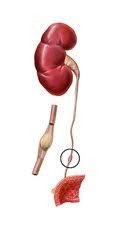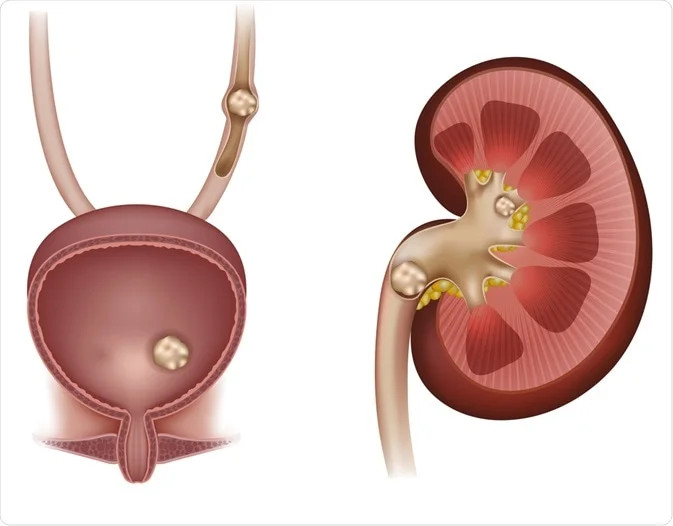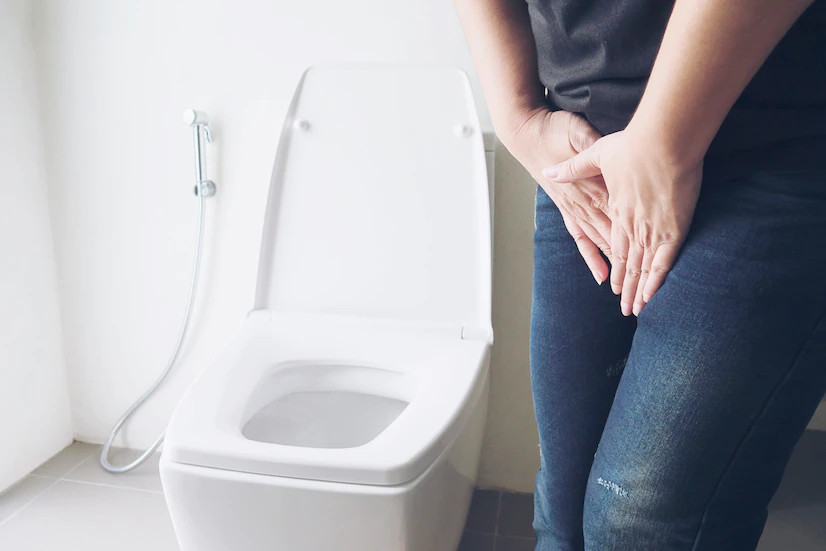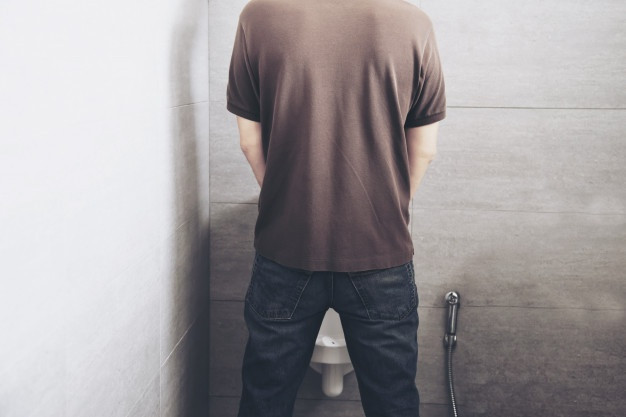Definisi
Ureterolitiasis adalah adanya batu di ureter, saluran yang membawa urine dari ginjal ke kantung kemih. Batu bisa melewati ureter tanpa menyebabkan gejala. Namun, beberapa batu dapat terperangkap dan menyumbat ureter. Biasanya, batu yang menyumbat ini berukuran cukup besar, sehingga ketika terjadi penyumbatan di ureter, bisa timbul nyeri perut mendadak yang terasa sangat sakit.
Ureterolitiasis adalah penyakit yang memengaruhi jutaan orang di dunia. Penyakit ini paling banyak menyerang orang dewasa paruh baya. Terdapat kemungkinan 1 banding 8 untuk terbentuknya batu di sepanjang hidup anda.
Penyebab
Mekanisme utama pembentukan batu adalah ketidakseimbangan antara zat utama penyusun endapan batu dengan kurangnya cairan untuk melarutkan batu. Komposisi kimia utama batu saluran kemih adalah:
1. Kalsium (70-80%)
Batu kalsium merupakan yang batu yang paling sering ditemukan, sekitar 80% dari seluruh kasus ureterolitiasis. Batu ini terbentuk pada orang dengan kadar kalsium dan oksalat yang tinggi di tubuh. Selain itu, batu ini juga dapat terbentuk akibat adanya:
- Peningkatan konsumsi kalsium
- Peningkatan penyerapan kalsium pada usus
- Penyerapan kalsium dari tulang yang berlebihan (misalnya pada hiperparatiroid, kondisi kelenjar paratiroid memproduksi hormon berlebihan di tubuh)
- Gangguan ginjal yang tidak mampu menyerap kalsium juga dapat menyebabkan penumpukan kalsium di urine
2. Struvit atau magnesium ammonium fosfat (10-15%)
Batu struvit dihubungkan dengan infeksi saluran kemih jangka panjang yang disebabkan oleh bakteri. Bakteri ini dapat memecah urea menjadi ammonium, yang kemudian akan bergabung dengan fosfat dan magnesium. Bakteri yang bisa menyebabkan kondisi ini adalah Proteus, Pseudomonas, dan Klebsiella. Untuk tipe batu ini, infeksi tidak akan hilang sampai batu dibuang. Batu struvit lebih sering ditemukan pada wanita. Wanita juga lebih berisiko untuk menderita pembengkakan pada ginjal akibat infeksi.
3. Asam urat (6-9%)
Batu asam urat berkaitan dengan konsumsi berlebihan makanan yang mengandung purin seperti:
- Jeroan
- Ikan
- Kacang-kacangan
Peningkatan purin juga bisa terjadi akibat adanya proses kanker. Batu ini juga berhubungan dengan adanya gout, suatu radang sendi yang terjadi karena penumpukan kristal asam urat (25% penderita batu asam urat menderita gout).
4. Sistein (1-3%)
Batu sistein merupakan tipe yang paling jarang. Penyebabnya adalah karena kelainan metabolisme yang menyebabkan ginjal tidak mampu menyerap sistein, sehingga zat sistein akan menumpuk pada urine dan membentuk batu.
Faktor Risiko
Umumnya ureterolitiasis terjadi pada orang-orang yang berusia 20 - 49 tahun, dengan usia puncaknya antara 35 - 45 tahun. Jarang ditemukan gejala batu yang baru pertama kali muncul pada orang yang berusia >50 tahun, begitu juga pada anak-anak <16 tahun. Pria berisiko menderita batu saluran kemih 3 kali lipat lebih tinggi daripada wanita. Keturunan Asia dan kulit putih lebih banyak menderita batu saluran kemih daripada keturunan Afrika Amerika, Afrika, dan Amerika. Kondisi lain yang berhubungan dengan batu saluran kemih adalah obesitas, tekanan darah tinggi, dan osteopenia (menurunnya densitas tulang).
Faktor paling penting dalam pembentukan batu adalah kurangnya asupan cairan. Jika asupan cairan berkurang, maka produksi urine juga akan berkurang sehingga konsentrasi zat pembentuk batu (kalsium dan oksalat) akan lebih tinggi. Diet juga memegang peranan penting dalam pembentukan batu. Diet yang tinggi protein hewani, garam, dan rendah cairan serta kalsium juga menjadi faktor risiko terbentuknya batu saluran kemih.
Gejala
Meskipun batu saluran kemih terbentuk di dalam ginjal, namun biasanya tidak menyebabkan nyeri akut (mendadak). Namun, batu yang berada atau sudah mencapai saluran ureter dapat menyebabkan nyeri hebat dan rasa tidak nyaman, yang terkadang dideskripsikan sebagai nyeri hebat yang lebih berat daripada saat melahirkan. Nyeri ini biasanya hilang-timbul atau datang dan pergi. Ureterolitiasis juga terkadang disertai dengan nyeri perut dan nyeri punggung.
Oleh karena batu dapat menimbulkan iritasi pada ureter, maka seringkali didapatkan darah pada urine. Urine bisa terlihat berwarna pink atau merah, walau bisa juga kandungan darah cukup sedikit, dan baru terlihat pada pemeriksaan urine menggunakan mikroskop.
Diagnosa
Pemeriksaan Laboratorium
Langkah pertama untuk mendiagnosa adanya batu ureter adalah dengan melakukan pemeriksaan urine. Pemeriksaan kultur urine (membiakkan bakteri yang ada di urine pada media khusus) juga dapat dilakukan untuk menemukan atau menyingkirkan adanya infeksi bakteri pada saluran kemih. Pemeriksaan fungsi ginjal biasanya tidak dilakukan dengan rutin, umumnya digunakan pada orang dengan riwayat penyakit ginjal atau yang mengalami komplikasi seperti pembengkakan ginjal yang signifikan. Analisis batu akan membantu menentukan komposisi batu, sehingga dapat menentukan terapi dan pencegahan yang tepat.
Pemeriksaan Pencitraan
Pemeriksaan radiologi seperti X-ray, CT scan, dan ultrasonografi dapat sangat membantu untuk mengevaluasi adanya batu. Oleh karena 80% batu saluran kemih terdiri dari kalsium, maka pemeriksaan X-ray berguna untuk menegakkan diagnosa (batu kalsium terlihat pada X-ray). Pemeriksaan CT scan dapat menunjukkan lokasi, ukuran, jumlah batu, serta pembengkakan ginjal.
USG memiliki keterbatasan karena tidak dapat mendeteksi lokasi batu di luar ginjal, serta kualitas pemeriksaan dipengaruhi oleh lemak tubuh dan gas saluran cerna. Namun, USG memiliki manfaat karena tidak memancarkan radiasi ionisasi sehingga aman untuk wanita hamil, wanita usia subur, dan pasien dengan batu berulang yang sudah menjalani beberapa kali pemeriksaan CT scan.
Tata Laksana
Pada penderita urolitiasis yang mengalami nyeri hebat, biasanya akan diberikan obat anti nyeri terlebih dahulu. Selain itu, obat untuk mual dan muntah juga dapat diberikan untuk mengatasi gejala tersebut bila ada. Dokter juga bisa memberi obat untuk merilekskan otot ureter sehingga diameter ureter menjadi lebih lebar dan batu dapat lewat menuju kandung kemih. Dokter akan memutuskan pemberian obat yang tepat sesuai dengan kondisi masing-masing orang.
Setelah keluhan teratasi, perlu dilakukan terapi untuk menghilangkan batu. Sekitar 80% batu yang berukuran kecil (<4 mm) dapat turun sendiri ke kandung kemih. Batu yang lebih besar sering membutuhkan prosedur bedah khusus untuk menghancurkan batu.
Jika sudah diketahui komposisi batu, maka dapat ditambahkan juga terapi yang spesifik untuk batu tersebut. Sebagai contoh, pada batu struvit, diberikan terapi untuk infeksi saluran kemih. Untuk batu sistein, dapat dilakukan terapi dengan mengatur diet atau pemberian obat pengikat senyawa sistein.
Komplikasi
Komplikasi yang bisa terjadi dari ureterolitiasis adlaah:
- Infeksi saluran kemih, infeksi bisa terjadi karena gangguan aliran urine akibat sumbatan batu. Adanya batu disertai infeksi akan lebih menyulitkan terapi. Biasanya salah satu gejala yang ditimbulkan adalah demam, menggigil, dan nyeri.
- Perlukaan atau bekas luka pada uretra.
- Perdarahan.
- Gangguan fungsi ginjal. Gagal ginjal kronis dapat terjadi akibat prosedur medis urologi (jarang terjadi) atau akibat sumbatan batu ginjal.
Pencegahan
Anda tidak akan menderita ureterolitiasis jika Anda tidak memiliki batu ginjal. Jika anda pernah menderita batu ginjal, maka dokter akan membantu untuk mencari tahu komposisi batu sehingga dapat membantu Anda mencegah pembentukan batu berulang. Dokter mungkin akan melakukan terapi sebelum batu turun ke ureter dan menyebabkan nyeri.
Diet yang dapat dilakukan untuk mencegah pembentukan batu secara umum adalah:
- Minum banyak air putih sesuai kebutuhan
- Batasi protein hewani (daging, telur, ikan)
- Batasi asupan garam (kurang dari 2 g per hari)
- Batasi oksalat (bayam, kacang-kacangan, gandum)
Dokter juga mungkin akan meresepkan obat untuk membantu mencegah pembentukan batu ginjal atau ureter, bila penyakit terjadi berulang.
Kapan Harus ke Dokter?
Anda perlu untuk mencari pertolongan medis segera jika Anda mengalami gejala seperti:
- Nyeri berat yang sampai menyebabkan Anda tidak dapat duduk diam atau menemukan posisi yang nyaman
- Nyeri yang disertai mual dan muntah
- Nyeri yang disertai demam dan menggigil
- Darah pada urine
- Kesulitan buang air kecil
Mau tahu informasi seputar penyakit lainnya? Cek di sini, ya!
- dr Hanifa Rahma
Ureterolithiasis: Leaving No Stone Unturned. (2022). Retrieved 22 June 2022, from https://www.jucm.com/ureterolithiasis-leaving-stone-unturned/
Glazer, K., Brea, I., & Vaitla, P. (2022). Ureterolithiasis. Retrieved 22 June 2022, from https://www.ncbi.nlm.nih.gov/books/NBK560674/
Ureteral Stones: Symptoms, Diagnosis, Treatments & Prevention. (2022). Retrieved 22 June 2022, from https://my.clevelandclinic.org/health/diseases/16514-ureteral-stones












